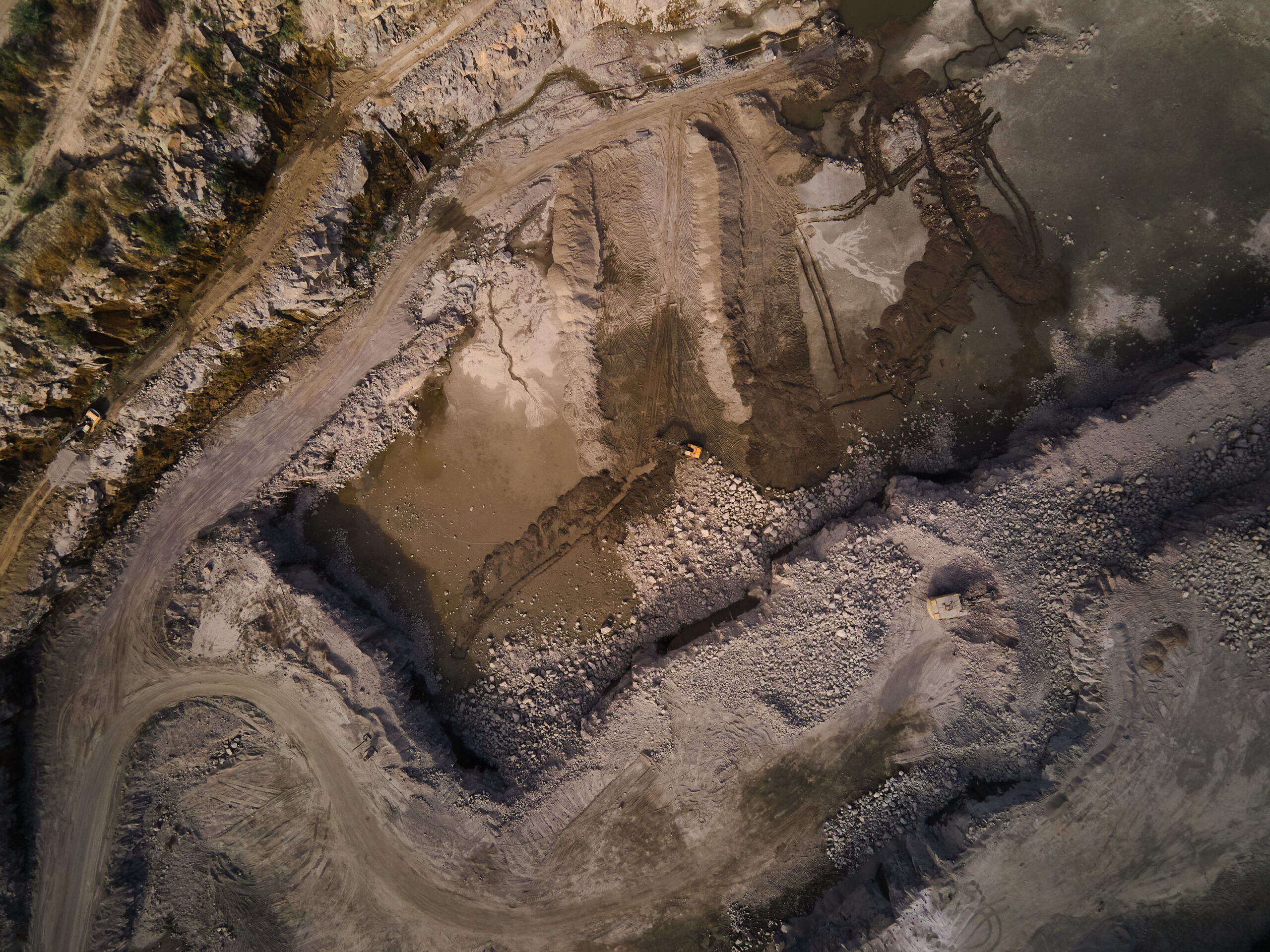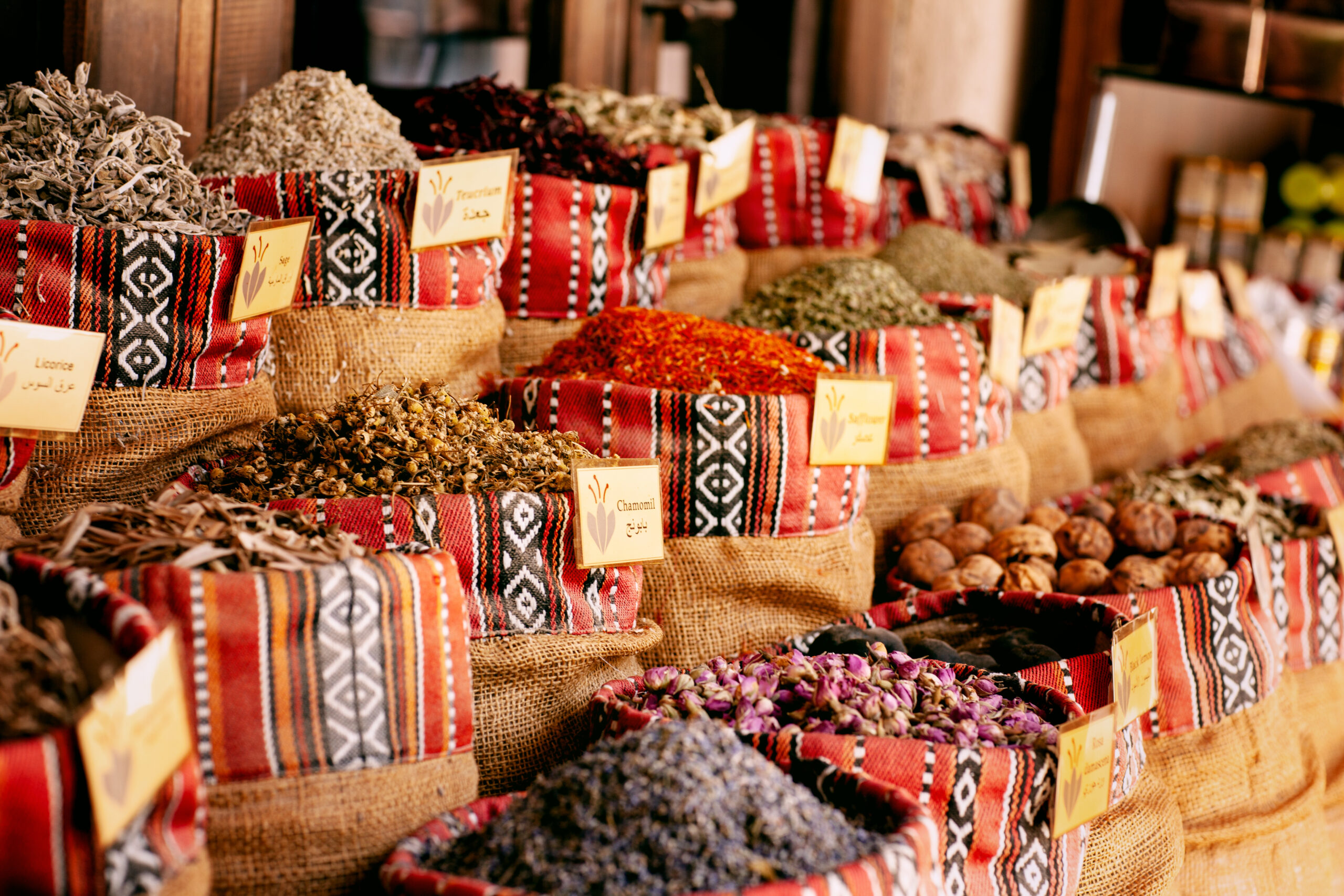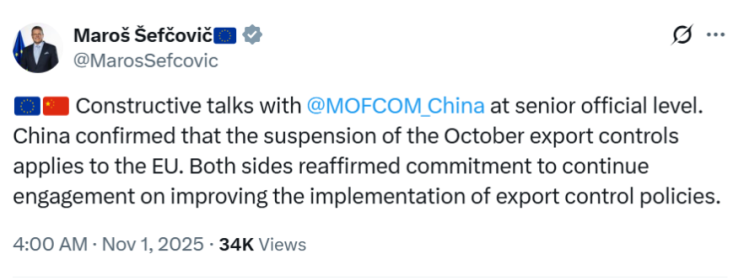#TradeViews has returned, with the hottest trade development in the EU bubble. This month, we delve into the EU-China bromance on critical raw materials, the never-ending odyssey of Transatlantic trade relations, the European Parliament’s stance on EU-Mercosur, and the latest on the (hopefully) upcoming EU-India agreement as well as on the brand-new EU-Uzbekistan Partnership agreement.
I am a strong, independent producer of Critical Raw Materials
October has been quite the busy month for critical raw materials diplomacy. Following last month’s announcement that China – the main global supplier of the rare earth materials used for magnets, batteries and electronics – would start applying heavy export restrictions on the coveted minerals last week, Beijing agreed to halt the restrictions for one year. EU Trade Commissioner Maros Šefčovič expects the decision, which came after a meeting between Chinese President Xi Jinping and US President Donald Trump, to also apply to the EU, although Brussels is reportedly still to receive an official confirmation from the Chinese government. On top of that, EU Trade Spokesperson Olof Gill also underlined that less stringent export controls on seven of the total 17 rare earth minerals will likely still remain in place.

The current uncertainty only adds to a month of tense debates on critical raw materials. During the last European Council – which preceded the announced halt to the measures – French President Emmanuel Macron reportedly called for the EU to activate its Anti-Coercion Instrument against China, allegedly without too much support from other heads of state.
Moreover, European Commission President Ursula von der Leyen has also announced an upcoming RESourceEU Plan – yes, inspired by REPowerEU – to boost the domestic production of CRMs and to diversify the EU’s roster of international suppliers. Notably, the plan will promote circular economy techniques to recycle and promote sustainable resource management of CRMs, together with new investments in strategic projects. In addition, the EU will also work towards new strategic partnerships with third countries such as Ukraine, Kazakhstan, Chile, Australia and Greenland.

As the plan is already expected to be published on 3 December, make sure to follow #TradeViews to remain up to date on CRMs diplomacy.
Our Take: China is responsible for the production of over 90% of processed rare earths. As the EU looks to claim its independence from Beijing for CRMs, the RESourceEU Plan might represent a key opportunity for the EU to invest not only in domestic supplies of strategic minerals but also in clean tech manufacturing, creating new opportunities for European businesses.
Zoom In: The EU has already started to invest in the manufacturing of rare earth permanent magnets, with the launch of a new plant in Narva, Estonia. Operated by the Canadian Neo Performance Materials, the plant has started providing a range of clean tech companies with magnets produced entirely with rare earths from Australia.
Zoom Out: EU Commission Executive Vice-President for Prosperity and Industrial Strategy Stéphane Séjourné underlined that, under the RESourceEU Plan, the EU will also create a joint purchasing and stockpiling centre for raw materials “based on the Japanese model”.
Have you ever seen a sunset (clause) so beautiful Mr. Trump?
The European Parliament is not very fond of the European Commission’s proposals to implement the trade deal with the US. In his draft report on the proposals, MEP Bernd Lange (DE, S&D), Rapporteur on the proposals and Chair of the EP’s INTA Committee, introduced several changes to the Commission’s text, quoting a “big appetite” from the Parliament to modify the texts.

Most notably, Lange proposed to introduce a “sunset clause” to limit the tariff concessions made by the EU to the US to a period of 18 months and ensure the agreement comes to an end in case there is no prospect of a fully WTO-compliant deal. Although the Danish Permanent Representation to the Council has rejected the possibility of such a clause being introduced, Lange still expects support from member states.
The report also proposes to only reduce EU countermeasures on steel and aluminium in case a sustainable and mutually acceptable arrangement with the US is reached. Finally, Lange proposes to introduce a safeguard mechanism to allow Brussels to suspend trade benefits in case zero-tariff imports caused a serious injury to EU industries, together with stronger provisions on the suspension of tariff preferences or tariff rate quotas.
On 4 November, MEPs in INTA expressed prudent support for Lange’s proposal, with the EPP calling for clarity over the condition for the potential suspension of the agreement and on the reduction of EU steel countermeasures. The Greens and Renew were more supportive of the report, with the Greens suggesting they will propose amendments going even further than those tabled by Lange. MEP Karin Karlsbro (Renew, SE), however, questioned whether the inclusion of a safeguard mechanism could risk undermining the deal. Finally, MEPs from the PfE Group reiterated their criticism for the trade agreement between the two blocs, arguing that the EU is “sacrificing European agriculture”.
EU-Mercosur: speak now, or forever hold your peace
If it’s true what they say about love, that you fall in love slowly, and then all at once; then the EU-Mercosur partnership could really be the love story of the year.
The Commission is doing its best to accelerate the deal’s ratification, by pushing for the Council to vote on the provisional application of the EU-Mercosur Partnership Agreement under qualified majority voting. The Council could vote on the issue during December 18-19 meeting, allowing President Ursula von der Leyen to sign the agreement during a ceremony to be held in Brazil on December 20.
To this end, the Commission has been lobbying member states. Last week, Commissioner Maroš Šefčovič met with Italian Foreign Minister Antonio Tajani and Agriculture Minister Francesco Lollobrigida, pledging to defend Italian agricultural products under the deal. Sefcovic’s negotiation skills appeared to have paid off, with Lollobrigida recognising that the deal could be beneficial for the Italian economy.
Meanwhile, INTA chair MEP Bernd Lange confirmed that the Parliament will adopt safeguards measures through the simplified voting procedure, in order to align the timeline of the file with that of the broader EU-Mercosur agreement. However, during the INTA Committee meeting of 3 November, MEPs were divided on the proposed safeguards. While the EPP welcomed the proposed measures, several other Groups expressed concerns on whether the new deal would ensure equal production standards and a level playing field for EU producers.
Furthermore, a group of Greens and Left MEPs plans to table a motion during the Parliament’s November plenary to challenge the EU–Mercosur deal before the European Court of Justice, arguing that the agreement’s rebalancing mechanism could allow Mercosur countries to challenge future EU legislation.
Just like in your favourite rom-com, it seems someone is ready to stand up in the church during the vows to oppose this holy union. Keep reading #TradeViews to know whether it will be yes!
New hopes for EU-India trade relations
On 28 October, Trade Commissioner Maros Šefčovič announced that the EU and India progressed substantially on the negotiations for an EU-India agreement. The breakthrough follows months of uncertainty as to when a deal could be achieved. While both parties are still aiming to secure an agreement by the end of the year, New Delhi’s stance on Russia and EU sustainability policies, together with India’s conservative attitude towards several key sectors (e.g. agriculture, cars, and car parts) have proven a particularly tough obstacle for trade talks between the two blocs.

However, it appears any contention is now a matter of the past, as DG TRADE’s chief negotiator Sabine Weyand is bound to travel to New Delhi this week to conclude technical negotiations on tariffs. According to Indian Minister for Commerce Piyush Goyal, Šefčovič will now return to India over the next two to three weeks to take the negotiations “to fruition”, potentially signalling the upcoming conclusion of the agreement.
Enhanced Partnership Agreement Ushers in New Era of EU–Uzbekistan Cooperation
On 24 October 2025, the EU and Uzbekistan signed the Enhanced Partnership and Cooperation Agreement (EPCA), establishing a long-term strategic economic partnership and strengthening bilateral ties. The EU is Uzbekistan’s third-largest trading partner, with trade nearly doubling from 2020 to 2024 and reaching €4.8 billion.

On trade, the EU acknowledged Uzbekistan’s progress in opening its market and encouraged the country to continue fair competition and enable a level playing field for European investors. The EPCA builds on these developments and aims to lower non-tariff barriers and streamline border procedures. In particular, it will prioritise human capital development, renewable energy, digital transformationand sustainable infrastructure. The ambition could already be felt as President Mirziyoyev met European company and bank directors in Brussels the day of the signing and pledged to pursue new collaborative projects worth over €10 billion in sectors such as energy, chemicals, critical minerals, logistics, textiles, and pharmaceuticals.
Over on X

On the radar
17 November | SEC Newgate EU will host a #BrusselsCalling panel on the changing media landscape with Raziye Akkoc (AFP), Kait Bolongaro (MLex), Stanley Pignal (The Economist) and Maria Tadeo (Euronews). Sign up here to join!
18 November | Euractiv will organize the Future of trade in industrial products – Consequences of the EU-US Trade Deal. The event will include both EU Officials and private sector experts to discuss the future of transatlantic trade.
20 November | The European Commission will host the Trade Policy Day 2025. The event will have panels on potential new trade alliances for the EU, the competitiveness of EU industries in the global market, and the resilience of global supply chains.
What we are reading
-
Eyes on the Indo-Pacific. The Council approved conclusions on the implementation of the EU Strategy for Cooperation in the Indo‑Pacific, focusing on security, green & digital transition and trade amid rising tensions in the Taiwan Strait and South China Sea.
-
It’s statements time. Today, the US Supreme Court will hear the first oral arguments on the appeal on the reciprocal tariffs imposed by the Trump Administration. In case the Court ends up confirming the tariffs are illegal, it is so far unclear what could potentially happen to the EU-US trade deal.
-
Kazakh Green Deal — EU’s new energy ally? As reported by Euractiv, Kazakhstan is positioning itself as a strategic partner for Europe’s green transition: offering rare-earths, green hydrogen and renewable power investment opportunities amid Brussels’ rush to diversify supply chains.
-
Simplify it, Maroš! Trade Commissioner Maroš Šefčovič’s latest Annual Progress Report highlights developments in cutting red tape across trade, customs and economic security. From the EU Customs Single Window to new digital “green lanes” for trusted traders, Brussels wants faster clearances and fewer forms. The report also reveals a push to align FDI screening, export controls and trade defense tools under a single “economic security doctrine”.
-
Peace deal, pause button. After Trump’s US-brokered peace agreement between Israel and Hamas, the EU’s long-discussed sanctions on Israeli ministers and settlers have been put on hold. With Germany and Hungary still opposed, diplomats say the plan won’t get the unanimous backing it needs. (EU unlikely to push sanctions on Israel after Trump peace deal – POLITICO Pro).



